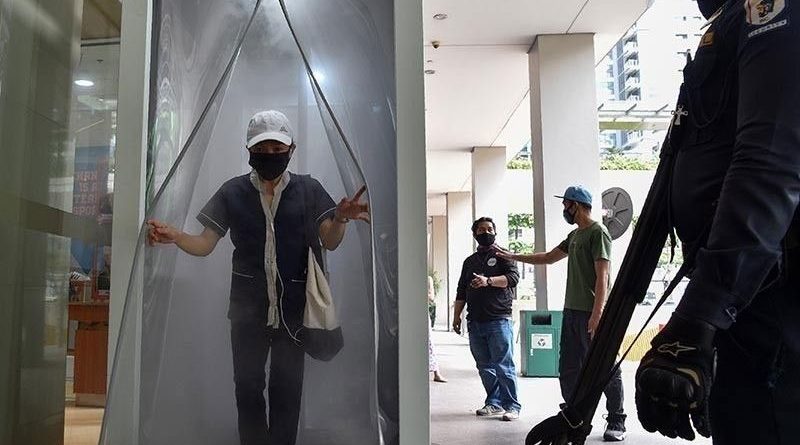HEADLINE: MANILA- DOH on rising cases: Next 2 weeks crucial
A security guard (R) watches as a shopper (L) exits from a disinfection channel installed at the entrance of a shopping mall as a preventive measure against the COVID-19 coronavirus, in Manila on May 16, 2020. /AFP/Ted Aljibe / Sheila Crisostomo (The Philippine Star ![]() – March 7, 2021 – 12:00am
– March 7, 2021 – 12:00am



MANILA, Philippines — The next two weeks are extremely important as this will determine if the country is able to manage the rising cases of COVID-19, Health Secretary Francisco Duque III said yesterday.
In an interview with The STAR, Duque noted these next two weeks are “important” for the country’s response to the pandemic.
“It will tell us if the (preventive) measures, the heightened response, have been effective. And how do you measure effectiveness? If you see cases going down and, hopefully, the health care system is not overwhelmed,” he added.
Duque said the rising number of COVID-19 cases “cannot be linked directly” to the presence of the UK and South African variants in the country.
He underscored that these two variants are “not as widespread” compared to the “most dominant” Hong Kong (HK) variant.
The HK variant accounts for 26 percent of swab samples sequenced, while the UK and South African variants account for three and 0.2 percent, respectively.
According to Duque, it is also not known if it is “coincidence” that the number of COVID-19 cases rose at the time when new variants are being detected in the country.
“It’s also a possibility that it is a combination of these variants and loosening up of quarantine restrictions, opening up of the economy and increase in the allowed capacity for public gatherings,” he added.
The health chief is also looking at the public’s “poor compliance” with the minimum public health standards as a contributing factor for the surge in cases.
Asked if there is a need to re-consider the easing up of restrictions, Duque said they may have to wait for two weeks first to see the situation.
He underscored that they have to see if the local government units (LGUs), especially those in areas with high COVID-19 cases, can bring down their cases.
“We know it is increasing, (but) has it increased to the point that our health system capacity is already overwhelmed?” he said.
Duque added that, currently, the health system is not yet overwhelmed, but there is already an increase in utilization rate in some hospitals.
“We have to see how far this is going to extend. But, of course, we don’t want our health system to be overwhelmed. The best preventive measures, for whatever variants, is strictly following health protocols,” he maintained.
.


Second wave?
The Department of Health (DOH) confirmed yesterday that there is a rise in the number of confinement of COVID-19 patients in past weeks.
According to DOH Usec. Maria Rosario Vergeire, they have been receiving reports that the number of COVID-19 patients in hospitals is on the rise.
She, however, said that the country is still not in a position when the rise in cases is “uncontrollable.”
“Nothing is uncontrollable at this point. We are trying to manage it,” she noted at a public briefing.
Vergeire also brushed aside insinuations that there is a second wave of cases in the country.
“There is a marked increase of cases but we are not going to say that it’s a ‘wave,” she added.
The official said it was a good thing that since November last year, hospitals have allocated “adequate capacity” for COVID-19 patients.
Vergeire added because of this, the health care utilization rates in COVID-19 wards in hospitals has not exceeded 50 percent.
“That is going to work for us right now, that we can accommodate more patients if ever,” she maintained.
Among the hospitals that are seeing an increase in COVID-19 patients is the Philippine General Hospital (PGH), one of the country’s referral centers for COVID-19.
PGH spokesman Jonas del Rosario said in a radio interview that they now have 102 confined COVID-19 patients.
He pointed out that this is up from the 60 to 70 patients admitted “within a week or so.”
Del Rosario added that when they had many cases a few months ago, they had to pull out health workers from the non-COVID-19 ward and re-assign them to the COVID-19 ward.
“Now that cases are increasing again, we might have to get these people again because we might open a ward. We closed this ward when cases went down. It seems we have to open it again,” he asserted.
.


New record
This, as the DOH recorded yesterday a new high in daily COVID-19 cases at 3,439, bringing the total cases to 591,138.
Based on the DOH’s Case Bulletin for March 6, the total number of active cases is 43,323, representing 7.3 percent of the overall cases.
The death toll rose to 12,465 after 42 patients succumbed to the virus. On the other hand, 160 individuals have recovered, raising the number of recoveries to 535,350.
.


Spreading ‘exponentially’
COVID-19 is once again spreading exponentially in some LGUs in Metro Manila, the OCTA Research Group warned.
From Feb. 26 to March 4, OCTA said the region recorded an average of 900 new cases per day, up by 50 percent from the previous week and 119 percent compared to two weeks ago.
“Nearly all the NCR (National Capital Region) LGUs in the list showed an increase in new COVID-19 cases, although some LGUs reported a marginal increase in new cases, such as Marikina and Las Piñas,” read the report.
“Unlike past surges experienced, the current surge has spread very quickly in a short period. The increase in cases and the reproduction number indicates that the virus is already spreading exponentially in several LGUs in the region,” it added.
Pasay City, for instance, recorded an average of 150 new cases per day in the past week, which OCTA said was the highest average daily new cases in its history.
Citing data from the DOH, the group said that the average number of new daily cases in the city last jumped from 87 in the preceding week and 41 two weeks ago.
It said the new average was higher than what Pasay reported during the surge in August 2020, when Metro Manila was placed under the stricter modified enhanced community quarantine.
Based on the data, Pasay City has an attack rate of 26.87 percent positive individuals per 100,000 population, putting it in a high-risk category. Its hospital occupancy is at 49 percent, well below the critical threshold of 70 percent, while its positivity rate – which measures the number of individuals who test positive out of the total tests conducted – is still low at six percent.
OCTA also identified Barangay 76 in Pasay as a COVID-19 hotspot, saying it recorded 128 new cases from Feb. 26 to March 4.
It also noted nearby barangays with a high number of cases, including Barangay 59 with 59 new cases in the past week; Barangay 183 with 56; Barangay 70 with 42 and Barangay 36 with 37.
But data from the Pasay City public information office as of Friday showed different figures from the monitoring report of OCTA.
For instance, Barangay 76 supposedly only has 10 confirmed active cases, with another 145 recoveries since the start of the pandemic last year.
Barangay 59 only has five confirmed active cases out of the total of 37 cases since last year; Barangay 183 with 32 active cases out of 888; Barangay 70 with only seven active cases out of 31 and Barangay 36 with only eight active cases out of 80.
In its update on Friday, Pasay said it confirmed 82 new active cases, bringing the total to 8,430 since the start of the pandemic last year. It currently has 7,725 recoveries and 222 deaths.
.


Still manageable
Despite being a serious cause for concern, OCTA said the surge in Metro Manila is in its early stages and could still be mitigated or even reversed.
It reiterated the possibility of new variants spreading in the region, citing the recent detection of the South Africa and UK variants in the country.
“While this still needs to be confirmed by genome sequencing, we believe that the surge may be driven by new and more contagious and lethal variants that could overwhelm the region if left unabated in the next few weeks,” the group said.
“It is important to stress the urgency of the situation as the UK and South African variants, which have already been identified in the NCR, are game-changing variants because they are more contagious and lethal and can potentially undermine our vaccination program,” it added.
OCTA recommended that the national government reevaluate the protocols for international travelers, saying that the entry of the new variants supports the call for stricter guidelines or stricter implementation of current policies.
“While we recognize the need to lift the travel ban and allow returning overseas Filipinos and foreign travelers to travel to the country, it is also apparent that there has been some level of ineffectiveness in the implementation of these protocols, or that perhaps we need to recalibrate some of our guidelines for the testing and quarantine of international travelers,” said the group.
It also urged the government to ensure the urgent but efficient deployment of vaccines this month, reiterating its call to health workers “to get themselves vaccinated as soon as possible with the available vaccines already procured by the government.”
“We subscribe to the belief that the best vaccine is the vaccine that is available at this time. For now, these are the vaccines developed by Oxford/AstraZeneca and Sinovac,” said OCTA. – Janvic Mateo











